

How to Meet Customers’ Needs in Uncertain Times. About Boston Consulting Group Boston Consulting Group partners with leaders in business and society to tackle their most important challenges and capture their greatest opportunities.

BCG was the pioneer in business strategy when it was founded in 1963. Today, we work closely with clients to embrace a transformational approach aimed at benefiting all stakeholders—empowering organizations to grow, build sustainable competitive advantage, and drive positive societal impact. Our diverse, global teams bring deep industry and functional expertise and a range of perspectives that question the status quo and spark change. BCG delivers solutions through leading-edge management consulting, technology and design, and corporate and digital ventures. . © Boston Consulting Group 2021. LinkedIn by Annapurna A. Our Brains Were Not Built for This Much Uncertainty. MIT Sloan Management Review. Topics Column Our expert columnists offer opinion and analysis on important issues facing modern businesses and managers.
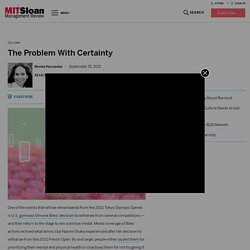
More in this series One of the events that will be remembered from the 2021 Tokyo Olympic Games is U.S. gymnast Simone Biles’ decision to withdraw from several competitions — and then return to the stage to win a bronze medal. Media coverage of Biles’ actions echoed what tennis star Naomi Osaka experienced after her decision to withdraw from the 2021 French Open. Although news stories of these events ultimately coalesced to commend these individuals for their bravery, the public’s initial reaction remained the same: People were certain that there was only one way to understand these actions.
Research Updates From MIT SMR Get weekly updates on how global companies are managing in a changing world. Please enter a valid email address. In this VUCA world, are we living in a "stupid mountain?" How to Embrace the Unpredictable. On managing complex change. Managing complexity (and chaos) in times of crisis. Turbulent Times Demand Dynamic Rules. Already a member?

Why Uncertainty Creates Pushback. What is your first response when you’re uncertain?

Depending on the circumstance, it could be worrying, looking for more information, hyper-vigilance, searching for reassurance, or a combination of all four. Your response is dependent on your tolerance for uncertainty. When you announce a change in your organization, you’ve naturally created uncertainty. The human skills we need in an unpredictable world. LinkedIn by Dave Snowden via Gail Severini. LinkedIn by Jurgen Appelo. How to manage under extreme uncertainty. In a time of crisis, especially one as deep and unique as the COVID-19 pandemic, uncertainty is extreme and information changes daily.
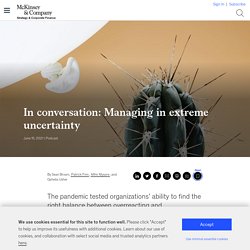
Most organizations realized that they lack the tools to manage effectively in such conditions. In this episode of the Inside the Strategy Room podcast, three McKinsey experts who are helping guide clients through the current crisis share the insights from their recent article, “When nothing is normal: Managing in extreme uncertainty.”
Patrick Finn is a leader in McKinsey’s Healthcare Systems and Services Practice, serving management teams on topics ranging from corporate and business-unit strategy to risk management and operations. Mihir Mysore is one of McKinsey’s most experienced leaders on crisis response, helping large organizations manage operational risk, stabilize crisis situations, and build resilience. They are joined by Ophelia Usher, an expert on resilience, crisis preparedness, and crisis response and recovery. Embracing Complexity: Fostering Change Using Systems Thinking. You might be wondering...
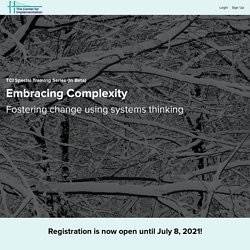
What do you mean when you say the training series is "in beta" or is a "beta test"? Complexity Explorer - Glossary. The general notion of dimension can be thought of as the number of different coordinates needed to specify a point distinctly from any other point.

In the framework of a fractal dimension, dimension relates the logs of the rate of change of a measurable aspect of a fractal pattern as it is iterated. The Hausdorff (or Hausdorff-Besicovitch) Dimension is a metric that can be used to calculate a fractal dimension of an object and is generalized as N = S^D. In this formulation, N is the number of pieces an object can be divided up into equally that have the same appearance as the original object (i.e. a square being divided up into smaller squares.)
S is the scale of N in relation to the larger object (i.e. when the parts of a 4x4 square are made into 16 1x1 smaller squares, the smaller pieces in relation to the whole object is said to have the scale factor of 4, or S of 4). Certainty artefacts: the constructs we create to make sense of the world. It began with a conversation a few months ago, which the 3A Institute and the Menzies Foundation convened around leadership.
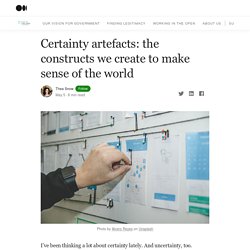
As part of that conversation, Genevieve Bell spoke about the need for leaders to create a sense of certainty for those around them; perhaps now more than ever. At first, I was resistant to this idea. At the Centre for Public Impact, we advocate for the importance of embracing complexity in government. I’ve highlighted the importance of avoiding the temptation to try to make the illegible legible. Turbulent Times Demand Dynamic Rules. VUCA: the four faces of change. Business Agility in a VUCA world: Maximising Change with speed and flexibility (10 March 2021) by Olu Hunter.
Change Models for VUCA – VUCA strategy requires different execution mindsets, approaches and capabilities (models) I got hooked this morning reading and thinking about how change is changing and how we can be more effective as leaders and as practitioners providing guidance to leaders.
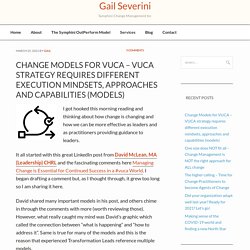
It all started with this great LinkedIn post from David McLean, MA (Leadership) CHRL and the fascinating comments here Managing Change is Essential for Continued Success in a #vuca World. I began drafting a comment but, as I thought through, it grew too long so I am sharing it here. David shared many important models in his post, and others chime in through the comments with more (worth reviewing those).
However, what really caught my mind was David’s graphic which called the connection between “what is happening” and “how to address it”. Same is true for many of the models and this is the reason that experienced Transformation Leads reference multiple models. How to Avoid Uncertainty Avoidance in the Workplace. Ambiguity affects some people more than it does others.
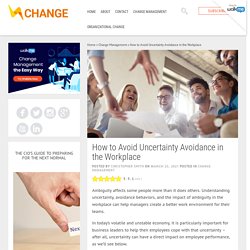
Understanding uncertainty, avoidance behaviors, and the impact of ambiguity in the workplace can help managers create a better work environment for their teams. In today’s volatile and unstable economy, it is particularly important for business leaders to help their employees cope with that uncertainty – after all, uncertainty can have a direct impact on employee performance, as we’ll see below. What Is Uncertainty Avoidance? Change Models for VUCA – VUCA strategy requires different execution mindsets, approaches and capabilities (models) On demand webinar: Change Management in Turbulent Times: Managing Unexpected,Ongoing Change During COVID & Other Crises.
To Manage Uncertainty and Loss, Emphasize the Benefits of Change. Over the past year, teams have had to cope with unprecedented levels of loss and uncertainty; some industries have changed more this year than in the last 20. As a leader, you recognize that your organization will need to continue to evolve if you’re going to survive—but how can you bring along a team that just wants some semblance of stability and normalcy? Prospect theory, as defined by psychologists Daniel Kahneman and Amos Tversky, states that people will avoid participating in change for as long as possible—not because they are afraid of what the future holds, but because they don’t want to lose all that they have worked to achieve.
The possibility of loss generates this strong sense of resistance because it’s very difficult for our brains to process the uncertainty of a future gain. The upside needs to be 1.5 to 2.5 times greater than the status quo for people to even register an outcome as positive. Make the outcomes of the change clear, and emphasize the positive gains. 3 Tips To Manage Uncertainty. Managing complexity (and chaos) in times of crisis. A field guide for decision makers inspired by the Cynefin framework (2021) Is #VUCA no longer up to date? Does #BANI describe the world we're in today much better?
On demand presentation: Future-proofing organizations. About VUCA and Sensemaking. VUCA Times Call for DURT Leaders. Thriving In Times Of Uncertainty. The world isn’t just changing faster today. It’s more complex, more ambiguous, and more unpredictable than ever before. In fact, data from both the Federal Reserve and the International Monetary Fund reveals that global uncertainty is at sky-high levels. This level of uncertainty is driven by many factors, including: 1) current trade tensions have the potential to rewrite significant rules for the highly global businesses of today; 2) climate change is challenging how organizations operate as pressure from stakeholders and governments to curb carbon emissions builds; 3) automation and AI have the potential to disrupt corporate strategy and impact job security; 4) the outbreak of the coronavirus has affected consumer demand and disrupted supply chains; and 5) with the first phase of Brexit underway, leaders have now been tasked with addressing concerns around its impact on trade, global markets, regulatory standards and labor flow.
Thriving In Sustained Ambiguity. As a strategist, I am very comfortable with ambiguity. After all, ambiguity is intrinsic to strategy development and execution. Uncertainty is the norm. Thus, I’ve been surprised by how challenging it has been for me to manage the pervasive uncertainty in today’s world. It seems as if ambiguity has taken over my life. My clients tell me the same thing. Like everyone else, my environment has changed. What complexity science says about what makes a winning team. ‘We know,’ Runciter said to GG, ‘that as individuals they perform well. It’s all down here on paper.’ He rattled the documents on his desk.
‘But how about together? How great a polyencephalic counter-field will they generate together? Ask yourself that, GG. In Philip K Dick’s classic science fiction novel Ubik, one of the main characters, Runciter, is in charge of assembling a team of individuals called ‘inertials’. Interest in collective behaviour is not new. Part of the reason why recruiters and others resort to going after the best players rather than building the best team is that it remains unclear what other factors contribute to team greatness, and how to quantify them. These seemingly at-odds results raise the question: how does a collective work exactly? Updates on everything new at Aeon. No individual can arrive even at the threshold of his potentialities without a culture in which he participates. We must acknowledge it’s difficult to know. When Managing Through Ambiguity, Develop a Clear Vision. When nothing is normal: Managing in extreme uncertainty. In normal times organizations face numerous uncertainties of varying consequence.
Managers deal with challenges by relying on established structures and processes. These are designed to reduce uncertainty and support calculated bets to manage the residual risks. In a serious crisis, however, uncertainty can reach extreme levels, and the normal way of working becomes overstrained. At such times traditional management operating models rarely prove adequate, and organizations with inadequate processes can quickly find themselves facing existential threats. Model of hierarchical complexity.
Embrace Complexity. RISE Report - Navigating Complexity. Unleashing sustainable speed in a post-COVID world: Rethink ways of working. September 8, 2020The pandemic has forced many businesses to navigate crisis conditions in new and unprecedented ways. Unleashing sustainable speed in a post-COVID world: Reimagine structure. September 21, 2020In the first blog post in this series, we discussed how many organizations were forced to accelerate numerous approaches to business (serving customers, working with vendors, collaborating with colleagues) due to the eruption of the coronavirus pandemic. Unleashing sustainable speed in a post-COVID world: Reshape talent.
September 28, 2020In parts one and two of this series on what organizations can learn from the pace at which many companies had to operate as the pandemic unfolded, we reviewed the first six actions that can help unleash sustainable speed. In this final post of the series, we address the last three actions—all aiming to reshape talent to get tomorrow’s leadership team operational today and to build the workforce capabilities of the future: The Uncertainty Mindset & the Future of Work.
Navigating deep uncertainty. How CEOs can navigate an uncertain economic future. Most chief executives have only navigated a decade of steady growth and prosperity. Coronavirus ended that overnight. Stunned bosses are trying to pivot out of this once-in-a-century event, while trying to future-proof their ailing businesses for the post-pandemic, day after tomorrow. Smart ones are quickly realising that COVID-19 is in fact a once-in-a-lifetime opportunity to reinvent their organisation.
Much-revered economist Klaus Schwab, founder and executive chairman of the World Economic Forum, has called for a “great reset of capitalism”. He explains that while the pandemic will have serious long-term consequences for economic growth, governments and the private sector must come together swiftly to “revamp all aspects of our societies and economies, from education to social contracts and working conditions”. This long-term recalibration is being considered alongside the short-term adaptation to the greatest cessation of economic activity in peace time.
Navigating deep uncertainty. Coping with uncertainty about workplace change. Coping with uncertainty about workplace change. Unknown. How to make smart decisions quickly in uncertain times. How to communicate effectively in times of uncertainty. To the Class of 2020... When More Information Leads to More Uncertainty. Making teams work in volatile and uncertain environments. Where To: Planning For Uncertainty. Future Shaper: How Leaders Can Take Charge in an Uncertain World (2020) by Niamh O'Keeffe. Generic Advertising "In These Uncertain Times" cartoon. Five perspectives on succeeding in uncertainty. How to Start Managing Change When the Change is Unclear. Why don't we just shut VUCA up! Learning how to outplay its influence! A Guide to Leading through Uncertain Times. Managing Change in Uncertain Times with Jason Little. Leading in truly uncertain times. - Dr Jen Frahm. How to Lead in Ambiguous Times. A test for leaders: Creating certainty amid uncertainty.
Navigating Uncertainty: Resources to Prepare for Change. Leadership During Times of Uncertainty. Leading In The Midst Of Uncertainty. Episode 81 of #commcast - This is a real case study on VUCA. Navigating Uncertainty: Resources to Prepare for Change. Special Update: How futurists deal with uncertainty. Managing Uncertainty cartoon. Is VUCA Increasing? 2020: Getting Down To Business Amidst A New World “Disorder” Is VUCA Increasing? Resilience in Uncertain Times: Insights From Global Leaders. TEDxLaval par Jean-Francois Lavallée. The human skills we need in an unpredictable world. LinkedIn by Stephanie Blackburn Freeth. Management de la complexité : de quoi parle-t-on exactement. Organizational culture and uncertainty.